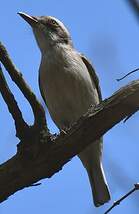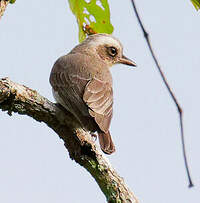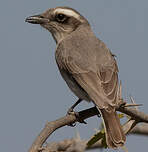Common Woodshrike
Tephrodornis pondicerianus - Téphrodorne de Pondichéry
Identification
Anglicans call it the Common Woodshrike, a translation for which could be common woods bird. The French name, Tephrodorne de Pondichéry, is perhaps more evocative or geographically appropriate, reminding us of classroom and commercial posts! Its Latin, and therefore French, name was attributed to German naturalist J.F. Gmelin (1748-1804), who placed the bird on the Coromandel coast, where Pondichéry is located. An exotic name and a perhaps changing classification: tephrodornithidae, prionopidae and, at the base, campephagidae (cuckoos). Let the scientists do their work. Our Common Woodshrike from Pondichéry measures from 15 to 18 cm and presents several shades of brown. Its cap is grey-brown, a wide white eyebrow outlines a black eye, encircled by a yellow orbital circle; parotids are very dark brown, almost black. The black beak has the external mandible slightly curved downward. The throat is white-cream, one can see some dark vertical stripes that are less pronounced on the abdomen; the underside is rather light. The nape and mantle are grey-brown, the coverts and primaries grey-brown, darker, the greater coverts show fine white edgings, a very marked white mark appears on the undertail coverts. The rectrices are dark brown, almost black. The legs are black. The female is identical to the male, with a lighter mask on the parotids. The juveniles have the upper coverts and flight feathers brown with white marks.
Subspecific information 3 subspecies
- Tephrodornis pondicerianus pondicerianus (e India to s Laos)
- Tephrodornis pondicerianus pallidus (Pakistan and nw India)
- Tephrodornis pondicerianus orientis (Cambodia and s Vietnam)
Foreign names
- Téphrodorne de Pondichéry,
- Ceniciento chico,
- cinzentão-pequeno,
- Indienvanga,
- Kleine Rupsklauwier,
- Averla boschereccia comune,
- vitbrynad skogstörnskata,
- Hvitbrynaskefugl,
- vangovec hvízdavý,
- stromovníček šedohnědý,
- Asketornskade,
- metsäkäpinkäinen,
- eruguera celluda,
- kruczodzierzb mały,
- Белобровый древесный личинкоед,
- モズサンショウクイ,
- 林鵙,
- นกเฉี่ยวดงธรรมดา,
- 林鵙,
Voice song and call
Habitat
Behaviour character trait
Dietfeeding habits
The Common Woodshrike is an insectivore, enjoying beetles, butterflies, their caterpillars, and spiders. Depending on the season or its habitat, it will feast on fruits as well. It can be seen in pairs or small groups, sometimes on the ground, looking for its food under dead leaves and in the crevices of trees.
Reproduction nesting
The breeding season runs from February to July, the nest is built in a tree, at a height of 2 to 9 m, by the couple; in the form of a small cup, the construction is neat, quite regular. It is made of moss, lichen, bark and roots, the interior is lined with fibers, grasses, mammal hair found during searches. The parents will incubate 2 to 4 eggs, at hatching only the female takes care of the fledglings. The flight learning period is poorly known.
Geographic range
The entire Indian Peninsula, Bangladesh, Pakistan (the Pallidus subspecies is lighter with less distinct black ear patches) and Sri Lanka (the Affinis subspecies is darker, with less distinct white eyebrow and shorter tail) and southern Nepal, is home to the Common Woodshrike. It is also present in Burma, Thailand, and parts of Indochina: Laos, Cambodia and Vietnam (the Orientis subspecies).
Threats - protection
Sources of information
- IOC World Bird List (v15.1), Gill, F and D Donsker (Eds). 2025-12-07.
- A Field Guide to the Birds of the Indian Subcontinent, Krys Kazmierczak, Ber Van Perlo
- A Photographic GUIDE TO THE BIRDS OF INDIA, Bikran Grewal, Bill Harvey, Otto Pfister
- Vol. 10 - Handbook of the Birds of the World, Josep del Hoyo-Andrew Elliott-David Christie
- ARKive, Christopher Parsons
- Avibase, Lepage Denis
- BirdLife International, BirdLife International
- Wikipédia, Wikipedia, The Free Encyclopedia
Other sources of interest
 Specification sheet created on
02/08/2023 by Anne et Gabriel Leboff
Specification sheet created on
02/08/2023 by Anne et Gabriel LeboffTranslation by AI Oiseaux.net
© 1996-2025 Oiseaux.net
- Accipitriformes
- Aegotheliformes
- Anseriformes
- Apodiformes
- Apterygiformes
- Bucerotiformes
- Caprimulgiformes
- Cariamiformes
- Casuariiformes
- Charadriiformes
- Ciconiiformes
- Coliiformes
- Columbiformes
- Coraciiformes
- Cuculiformes
- Eurypygiformes
- Falconiformes
- Galliformes
- Gaviiformes
- Gruiformes
- Leptosomiformes
- Mesitornithiformes
- Musophagiformes
- Nyctibiiformes
- Opisthocomiformes
- Otidiformes
- Passeriformes
- Pelecaniformes
- Phaethontiformes
- Phoenicopteriformes
- Piciformes
- Podargiformes
- Podicipediformes
- Procellariiformes
- Psittaciformes
- Pterocliformes
- Rheiformes
- Sphenisciformes
- Steatornithiformes
- Strigiformes
- Struthioniformes
- Suliformes
- Tinamiformes
- Trogoniformes
























